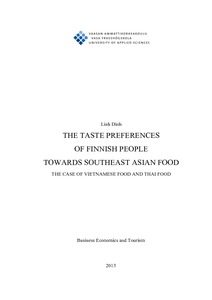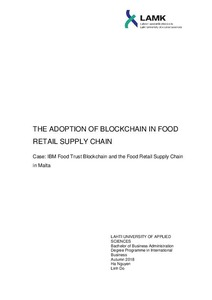Innovative Approaches to Food Waste Management : Leveraging Mobile Responsive Cloud Solution for Effective Redistribution
Wickrama Arachchi, Kanchan Randesh (2025)
Wickrama Arachchi, Kanchan Randesh
2025
All rights reserved. This publication is copyrighted. You may download, display and print it for Your own personal use. Commercial use is prohibited.
Julkaisun pysyvä osoite on
https://urn.fi/URN:NBN:fi:amk-2025061022040
https://urn.fi/URN:NBN:fi:amk-2025061022040
Tiivistelmä
Food waste is a significant global challenge with profound economic, social, and environmental impacts, especially in countries like Sri Lanka. This study explores food waste in Sri Lanka's food industry, focusing on the challenges hindering surplus food redistribution. Although it is a crucial aspect of addressing food waste, it is often overlooked and deserves more attention. The findings reveal that while sales promotions and discounts partially lower waste, large quantities of edible food are still discarded, making food insecurity worse among vulnerable groups such as foster children's homes, elder care facilities, and similar setups.
This research identifies key challenges in redistributing surplus food, including limited donor motivation, the absence of a coordinating body, and various operational barriers. To address these issues, the study introduced No2Scrap, a cloud-based, mobile-optimised software tool. This enables organisations seeking food donations to submit their needs as requests, while food enterprises can submit surplus food as donations. The system matches these inputs and helps bridge the coordination gap, enhancing the redistribution process with the involvement of community volunteers.
Furthermore, the study points to the urgent need for collective action among government bodies, food enterprises, and local communities. It also highlights the importance of supportive policies and public awareness in ensuring the success of surplus food redistribution.
This research identifies key challenges in redistributing surplus food, including limited donor motivation, the absence of a coordinating body, and various operational barriers. To address these issues, the study introduced No2Scrap, a cloud-based, mobile-optimised software tool. This enables organisations seeking food donations to submit their needs as requests, while food enterprises can submit surplus food as donations. The system matches these inputs and helps bridge the coordination gap, enhancing the redistribution process with the involvement of community volunteers.
Furthermore, the study points to the urgent need for collective action among government bodies, food enterprises, and local communities. It also highlights the importance of supportive policies and public awareness in ensuring the success of surplus food redistribution.
Kokoelmat
Samankaltainen aineisto
Näytetään aineisto, joilla on samankaltaisia nimekkeitä, tekijöitä tai asiasanoja.
-
The Taste Preferences of Finnish People Towards Southeast Asian Food : The Case of Vietnamese Food and Thai Food
Dinh, Linh (Vaasan ammattikorkeakoulu, 2013)The aim of this research was to reveal the interest level for Southeast Asian food in Finland by studying the attitudes of Finnish people towards Southeast Asian food; in this research are Vietnamese food and Thai food. ... -
The Adoption of Blockchain in Food Retail Supply Chain : Case: IBM Food Trust Blockchain and the Food Retail Supply Chain in Malta
Nguyen, Ha; Do, Linh (Lahden ammattikorkeakoulu, 2018)The year 2008 witnessed the birth of Bitcoin, a cryptocurrency that has partly kindled the blazing flame of Industry 4.0. As the archetypal representative of this age, blockchain has proven itself to be not only the power ... -
Sustainable marketing strategies: Understanding generation z’s expectations of food business in Spain: Study of the food consumption behaviour of the Spanish Generation Z
Calatayud Salinas, Elena (2020)This study aims to discover the consumption trends of the part of Generation Z that follows a sustainable diet with respect to food. The final aim of the thesis is to help food companies to better understand generation Z’s ...



